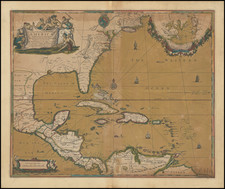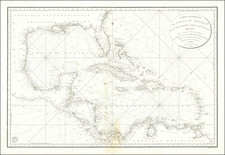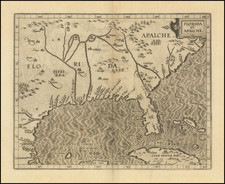A Beautifully Rendered Plan for a French Colonial Military Installation in Guadeloupe -- Shows Slave Housing and a Neighboring Sugar Plantation.
Pen and watercolor manuscript of Camp St. Charles, an installation that was projected as a forward operating base for Fort St. Charles, a major French base in Basse-Terre, Guadeloupe.
The present manuscript map was done by or for Emmanuel Marie Philibert, a major French architect and military engineer active in the colonies at the beginning of the 19th century. The map is closely related to a series of manuscripts in the collection of the Archive Nationale Outre-Mer (French Overseas National Archives) which cover Philibert's large-scale projects undertaken in the Antilles from 1817-1819 (and later). In particular, this map is a more highly finished version of another map of Camp St. Charles in the ANOM collections.
Details of the Map
The key to the map numbers 55 points of interest including the lodgings of the officers of the 89eme Légion and their names, dungeon and prison (38 & 39), herbs from Guinea (50), old destroyed hospitals (44), etc.
Outside of the grounds of the camp, the map covers a plantation with points of interest lettered. There is a sugar mill ("Sucrerie et dépendances") adjoining a road with "Cases à nègres " (housing for slaves) ("D"). "B" is the house of the overseer of the plantation.
Emmanuel Philibert
Not much is known of Philibert's life before he joined the Corps du Génie (Royal Engineer Corps). He was born in Cluny en Saône-et-Loire on October 14, 1768. He joined the Corps du Génie in 1793 and was active throughout the Revolutionary and Napoleonic Wars. After the Restoration, he left Normandy for Guadeloupe and arrived there in 1816.
Philibert was tasked with improving the infrastructure of the French military in Guadeloupe, under the direction of the new governor of the colony, Lieutenant-General Comte de Lardenoy. Guadeloupe had recently been returned to France by the Treaty of Paris (1814), and securing the territory from external and internal threats (i.e., slave revolts) was a priority.
Public health was also an overriding concern. Philibert had arrived on Guadeloupe with two other officers from the Corps du Génie and two guards, however, his subordinates all died of yellow fever (along with many other soldiers) shortly after they arrived. This left Philibert alone to execute his duties. Philibert was almost overwhelmed by the tasks at hand:
Arriving in this unfortunate country, I found everything to do. Knowing little of the Navy's service, without instructions, law or regulations, I was for a long time embarrassed. The English left no paper or records and all the buildings in the greatest disorder. Thanks to Mr. Quillet, I found some books and old registers and very old plans eaten two-thirds by insects [...]. It is a long and painful job in a country where it is extremely hot and where the sun is tiring we do not have any more. - Emmanuel Philibert, translated from a passage in Kissoun (page 10)
Interestingly, Lardenoy criticized some of Philibert's designs, calling them insalubrious:
We know that refreshing air is one of the main causes contributing to the reduction of the insalubrity of places inhabited by a large number of individuals. It is essential, especially in climates where the contagiousness of a great number of diseases is so rapid and so forceful, that the buildings intended for the accommodation of troops, and especially the hospitals, are so disposed as to promote air currents as much as possible. In the large hospital project of M. Philibert, the different buildings are not sufficiently isolated. The air would circulate badly in the courtyards which they form between them... the different bodies of buildings which compose it may be given a more advantageous arrangement by completely isolating them from each other and placing them in such a manner as to enhance the action of the prevailing winds ... One would walk from one building to another via covered galleries, where the convalescents could promenade during the heat and the bad weather. - Comte de Lardenoy quoted in Gauvin Alexander Bailey, Architecture and Urbanism in the French Atlantic Empire, page 381.
When Philibert sought the rank of lieutenant-colonel, Lardenoy provided him with a favorable recommendation:
M. Philibert has long and honorable service in Europe. Since he has been in this colony, he has not ceased to deploy useful knowledge. I owe the highest praise to his merit and above all to his sustained zeal, while his courage braved the bad weather and the cruel yellow fever which he triumphed twice. - Comte de Lardeony, translated from Kissoun (page 11)
Philibert died of a fever in 1828 and was buried at For Saint Charles, with full military honors.
See Bruno Kissoun's "Emmanuel Philibert: de la Grande Armée aux fortifications de Guadeloupe" in Bulletin de la Société d'Histoire de la Guadeloupe (2011) for an exhaustive treatment of Philibert's career and work on the island.









![[Rare Blaeu West Indische Pascaert Wall Map Section] Insulae Americanae in Oceano Septentrionali, cum terris adjacentibus](https://storage.googleapis.com/raremaps/img/small/75672.jpg)




